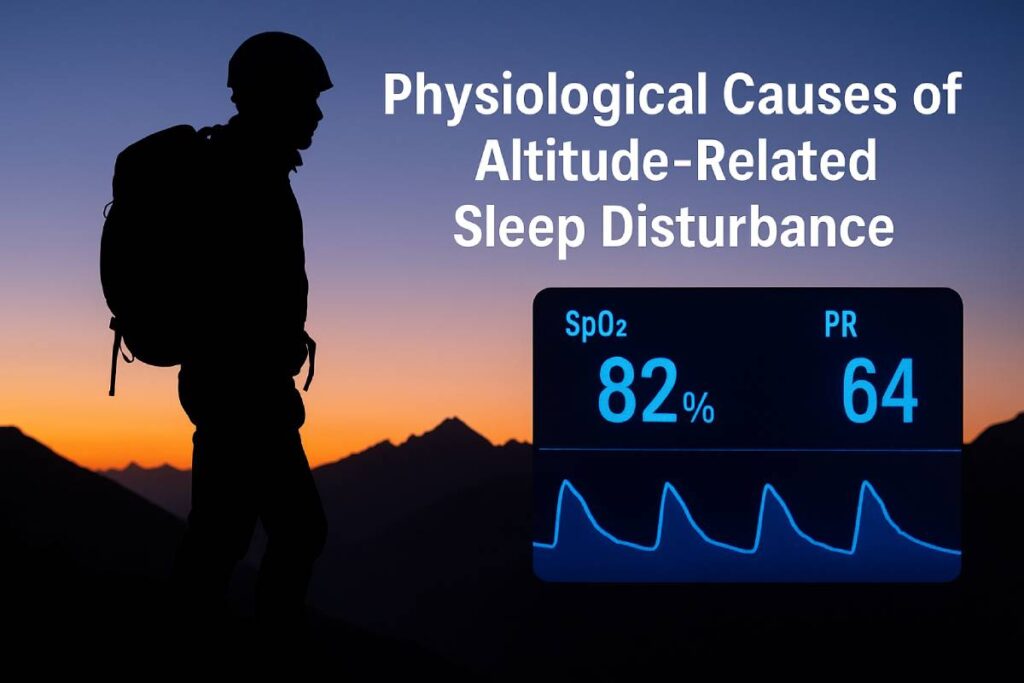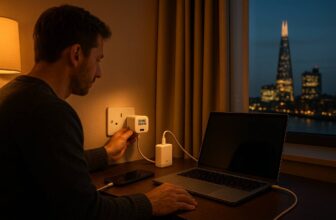Imagine lying awake in a rustic mountain cabin, the Milky Way shimmering through frosted windows, yet rest feels miles away.
Up here, thin air (hypobaric hypoxia) destabilizes your respiratory control, sparking cycles of hyperventilation and central apneas that jolt you awake.
And you’re not alone: between 32 % and 74 % of travelers report poor sleep quality or insomnia during their first nights in the high country.
In this guide, you’ll uncover the science behind altitude-related sleep woes, actionable tricks to reclaim rest tonight, prevention blueprints for future trips, and a clear acclimatization roadmap—so you can wake refreshed and ready for your next summit.
Physiological Causes of Altitude-Related Sleep Disturbance

In this section, we explore how the thin air of high elevations disrupts your breathing and sleep: hypobaric hypoxia at altitude destabilizes respiratory control, leading to periodic breathing and frequent arousals; the risk of central sleep apnea jumps from roughly 25 % above 2 500 m to nearly 100 % above 4 000 m; and these breathing disturbances shift you out of deep and REM sleep into lighter stages, fragmenting restfulness.
Hypobaric Hypoxia and Sleep Architecture
High elevations mean lower barometric pressure and reduced oxygen availability (hypobaric hypoxia), which triggers unstable breathing patterns at night. This instability manifests as periodic breathing—cycles of hyperventilation alternating with central apneas—that lead to repeated brief arousals and fragmented sleep. Such fragmentation not only wipes out restorative deep sleep but can also cause daytime fatigue and impair cognitive performance.
Altitude Ranges and Risk Levels
As you climb higher, the likelihood of central sleep apnea rises dramatically. Here’s how risk scales with elevation:
| Altitude Range | Prevalence of Central Sleep Apnea | Notes & Sources |
|---|---|---|
| > 2 500 m | ~ 25 % | High-altitude CSA affects ~ 25 % above 2 500 m |
| > 4 000 m | ~ 100 % | Nearly all sojourners exhibit periodic breathing and CSA above 4 000 m |
| > 2 000 m (susceptible) | Occasional cases | Occurs in susceptible individuals above 2 000 m |
| > 5 000 m | Most subjects | Central apneas are almost universal above 5 000 m |
Impact on Sleep Stages
High altitude not only alters your breathing but reshapes your sleep architecture:
- Increased light sleep (Stage 1–2): Time spent in light NREM sleep goes up sharply, with Stage 1 rising significantly from elevations as low as 3 500 m.
- Reduced slow-wave (deep) sleep: Slow-wave sleep (SWS), crucial for restoration, decreases progressively with altitude, undermining physical recovery.
- Variable REM sleep: While some studies report preserved REM duration, others note delays in REM onset and overall reductions at extreme elevations.
These shifts—more light sleep, less deep and REM sleep—mean your night is broken into lighter, less restorative segments, leaving you feeling unrefreshed and drowsy the next day.
Written by a seasoned travel expert who’s slept at every elevation from foothills to base camps. Understanding these physiological effects is your first step to planning a high-altitude trip without trading sleep for scenic views.
Symptoms and Symptom Checklist
Travelers heading above 2,500 m often find that sleep doesn’t come easy: difficulty falling asleep, periodic breathing events that jolt you awake, vivid, restless dreaming, and lingering daytime drowsiness are more than just anecdotes—research shows that 32 – 74 % of sojourners report one or more of these disturbances during their first nights at elevation. These symptoms stem from hypoxia-induced ventilatory instability in thin air, leading to fragmented sleep and impaired recovery. Recognizing these warning signs allows you to plan effective countermeasures—so you can focus on the adventure, not the altitude.
Symptoms and Symptom Checklist
Below is a breakdown of the key sleep-related symptoms you may experience at high elevation:
| Symptom | What You Feel | Key References |
|---|---|---|
| Insomnia | Difficulty initiating sleep despite feeling tired | Sleepably: insomnia common at altitude; AAFP: insomnia one of AMS symptoms |
| Frequent awakenings | Brief arousals from periodic breathing (hyperventilation followed by pauses) | MedLink: central sleep apnea & periodic breathing above 2,500 m; Thoracic Key: periodic breathing major disruptor |
| Restlessness & nightmares | Vivid, disjointed dreams; tossing and turning | IT Medical Team: vivid dreams common at altitude; Elevation Outdoors: radical dream shifts; Mighty Travels: 45 % jump in lucid dreams |
| Daytime drowsiness | Cognitive sluggishness, impaired focus, persistent fatigue | AAFP: fatigue often accompanies insomnia at altitude; High Alt Med Biol: up to 80 % report sleep disturbances/fatigue |
Prevalence Note: Studies find that 32 – 74 % of people ascending to high altitude experience poor sleep quality—insomnia, awakenings, or daytime fatigue—during their first days above 2,500 m.
By keeping an eye on these symptoms, you can decide when to apply preventive measures—like controlled ascent profiles, supplemental oxygen, or professional evaluation—and ensure that your high-altitude adventure remains memorable for the views, not the sleepless nights.
Immediate Relief Strategies (What to Try Tonight)
Below are three science-backed strategies you can try tonight to reclaim restful sleep at high elevations. Elevating your head by about 30° helps keep your airway open and reduces apneic pauses. Pair this with slow, diaphragmatic breathing to stabilize your ventilation and improve oxygenation. Next, transform your room into a dark, quiet cave—blackout curtains, earplugs, and a white-noise machine drown out light and sound disruptions. Finally, gentle, natural aids like low-dose melatonin (0.5–3 mg), chamomile tea, and valerian root can ease you into sleep without heavy grogginess.
Breathing Techniques and Positioning
- Head-of-Bed Elevation
Elevate your mattress or use wedges so your head and torso form roughly a 30° angle—this “HOBE” position reduces upper-airway collapses and periodic breathing at altitude. - Diaphragmatic (Belly) Breathing
- Lie on your back with one hand on your chest and one on your belly.
- Inhale slowly through your nose, feeling your diaphragm (not your chest) expand.
- Exhale fully through pursed lips, allowing your belly to fall.
Practicing 5–10 minutes of this before bed enhances oxygen flow, lowers heart rate, and can reduce anxiety-related arousals.
Sleep Environment Optimization
Creating a stable, low-stress setting is critical when your body is already under hypoxic strain.
- Block Light: Heavy blackout curtains or a well-fitting eye mask prevent stray beams from aborting melatonin release.
- Drown Noise: Earplugs or a white-noise machine mask unpredictable sounds—especially useful in mountain lodges or busy hostels.
- Maintain Cool Temperature: Aim for 16–19 °C (60–67 °F); studies show a cooler room helps you fall asleep faster and stay asleep longer.
Natural Remedies and Supplements
Below is a quick reference table of mild, drug-free options you can take tonight. Always start at the low end of the dose range and consult your healthcare provider if you have chronic conditions.
| Supplement | Typical Dose | Key Benefit | Sources |
|---|---|---|---|
| Melatonin | 0.5–3 mg, 30 min before bed | Resets disrupted circadian rhythms; reduces sleep latency | time.com |
| Chamomile Tea | 1 cup (≈2 g dried herb) | Promotes relaxation; improves overall sleep quality | healthline.com |
| Valerian Root | 300–600 mg extract | May decrease time to fall asleep; mild sedative action | healthmatch.io |
| Magnesium | 200–400 mg | Supports GABA function; relaxes muscles | health.com |
| L-Theanine | 100–200 mg | Boosts GABA; eases anxiety | health.com |
By a travel expert who’s tested these tactics from the Alps to the Andes—sleep well and wake ready for tomorrow’s summit!
Prevention and Preparation for High-Altitude Sleep
High-altitude sleep prep boils down to three pillars: pre-acclimatization, hydration & diet, and smart ascent planning. Exposing yourself to simulated altitude—via staged ascents or tents—for just 1–4 hours daily over 1–5 weeks can kickstart ventilatory adaptations, reducing altitude sickness symptoms for up to a week after exposure. On the nutrition front, aim for 12–16 cups of water per day, a high-carb/low-salt diet, and steer clear of heavy meals or alcohol close to bedtime to keep dehydration and sleep fragmentation at bay. Finally, plan your climb so you never sleep more than 500 m higher each night, incorporate low-intensity exercise on arrival, and schedule rest days every 3–4 days—this gradual approach gives your body the best shot at normalizing sleep architecture above 2,500 m.
Pre-Acclimatization Protocols
Staged exposure before departure can blunt the shock of thin air:
- Staged Ascents: Spending 2–3 days at intermediate elevations (e.g., 2,500–3,000 m) before pushing higher gives your body time to upregulate red-cell production and stabilize breathing.
- Simulated Altitude Tents: Daily sessions of 1–4 hours in hypoxic tents set to ~4,000 m over 1–5 weeks trigger ventilatory and autonomic adaptations, cutting your acute mountain sickness risk and improving sleep quality.
- Hypoxic Exercise: Combining intermittent hypoxia with light exercise further enhances your tolerance, preparing both your cardiovascular and respiratory systems for the real mountain environment.
- Carry-Over Effect: A week-long hypoxia protocol can sustain protective effects—like reduced Lake Louise Scores—for up to one week after the final exposure.
Hydration and Diet Recommendations
What you eat and drink shapes how you handle altitude-induced stress and sleep:
| Recommendation | Benefit | Source |
|---|---|---|
| Hydrate (12–16 cups/day) | Prevents dehydration (which mimics or worsens altitude sickness) and supports restful sleep | altitudecontrol.com & Backcountry Foodie |
| High-Carb, Low-Salt Diet | Stabilizes blood sugar, improves oxygen delivery, and enhances acclimatization | altitudecontrol.com |
| Avoid Alcohol | Reduces diuresis and sleep fragmentation caused by hypoxia and ethanol | altitudecontrol.com |
| Skip Heavy Meals Pre-Bed | Minimizes reflux and digestive strain, promoting uninterrupted sleep cycles | altitudecontrol.com |
Physical Conditioning and Timing of Ascent
How you move—and ascend—matters just as much as what you eat:
- Low-Intensity Exercise on Arrival: Gentle activity (walking, stretching) in the first 24 hours maintains ventilatory drive without overtaxing fatigued muscles.
- Gradual Ascent Rules: Above 2,500 m, increase your sleeping altitude by no more than 600–1,200 m per 24 hours; above 3,000 m, aim for ≤ 500 m daily with an extra rest day every 1,000 m gained.
- Scheduled Rest Days: Incorporate rest every 3–4 days to allow full physiological adaptation—this pacing markedly reduces sleep disruption and AMS risk.
- Pre-Trip Timing: If you’re an endurance athlete, arriving 7–10 days before an event at elevation gives you a performance edge; sea-level‐based pre-acclimatization strategies can fill any gaps if time is tight.
As a travel expert who’s guided beginners and pros alike from basecamp to summit, these prevention tactics will help you sleep soundly so you can focus on the views—not the altitude.
Medical Treatments and When to Seek Professional Help

Here’s how to navigate medical interventions and know when to get professional help on a high-altitude trip:
At high altitude, targeted medications like acetazolamide can smooth out your nighttime breathing, boosting oxygenation and cutting down on disruptive apneas. If sleeplessness or fragmented rest sticks around past the first 72 hours—longer than most acute mountain sickness (AMS) symptoms do—you should see a healthcare provider to rule out AMS and prevent its progression. And never ignore red flags like breathlessness at rest, chest pain, confusion, or ataxia—these are hallmark warning signs of life-threatening pulmonary or cerebral edema that demand emergency care.
Pharmacological Options
When lifestyle tweaks aren’t enough, a doctor may prescribe acetazolamide to help normalize your breathing pattern at night.
| Medication | Dose | Key Benefit | Source |
|---|---|---|---|
| Acetazolamide | 125–250 mg twice daily | Improves nocturnal oxygenation and reduces periodic breathing at altitude | PMC & PubMed |
- How it works: By creating a mild metabolic acidosis, acetazolamide stimulates ventilation, raising blood oxygen levels and smoothing out the cycles of hyperventilation and apnea that plague high-altitude sleep.
Indications for Medical Consultation
Most altitude-related sleep issues settle within 48–72 hours as your body acclimatizes, but if poor sleep persists beyond three days, it may signal evolving AMS rather than mere “bad jet lag.”
- Persistent insomnia or severe fragmentation: When you can’t initiate sleep or stay asleep past 72 hours, ask your healthcare provider to evaluate for AMS—insomnia was historically part of the Lake Louise AMS score and remains a key comfort check for altitude illness.
- Associated symptoms: If troubling sleep comes with headache, nausea, dizziness, or fatigue that doesn’t improve with rest, professional assessment is essential to prevent progression to cerebral or pulmonary edema.
Emergency Symptoms
Certain warning signs require immediate descent and medical attention—don’t wait for normal acclimatization if you notice any of these:
| Symptom | Possible Condition | Source |
|---|---|---|
| Breathlessness at rest | High-altitude pulmonary edema (HAPE) | StatPearls: hallmark dyspnea at rest |
| Chest pain or tightness | Pulmonary edema or cardiac stress | Physio-Pedia: HAPE chest tightness |
| Confusion or altered mental status | High-altitude cerebral edema (HACE) | StatPearls: HACE confusion/altered status |
| Ataxia (loss of coordination) | Advanced HACE | Cleveland Clinic: HACE ataxia warning |
Action: If you—or a travel companion—develop any of these signs, descend immediately (ideally 1 000–3 300 ft/300–1 000 m) and seek emergency medical care or supplemental oxygen without delay.
As a travel expert who’s trekked from the Andes to Everest Base Camp, I’ve seen how timely medical interventions can mean the difference between a restless night and a safe adventure. Always carry a medical plan, know your red-flag symptoms, and don’t hesitate to seek help—your health is the foundation of every summit.
Acclimatization Timeline and Expectations
Below is what you can expect in the days and weeks after you arrive at high elevation—so you know when to push on, rest up, or seek help.
In the first 48–72 hours, your sleep is typically most disrupted: up to 74 % of sojourners report very poor sleep or insomnia on Night 1, with vivid dreams, frequent awakenings, and shallow stages of sleep dominating your rest. Roach et al. found that at 3 600 m, both sleep duration and perceived quality plunge on Night 1 compared to sea level.
By Night 3 at 4 559 m, oxygen saturation and some sleep‐stage patterns begin to rebound, though periodic breathing often persists. Overall, acute acclimatization—characterized by a steady rise in ventilation and partial stabilization of sleep architecture—occurs over the first 3–5 days and is mirrored by measurable improvements in loop-gain and apnea severity after three nights.
From one week onward, most travelers notice significant gains in both daytime energy and nocturnal rest. Physio-pedia reports that partial acclimatization—enough to restore near‐normal performance and sleep—can be achieved within 5–7 days of continuous exposure. Studies link these gains to improved ventilatory control (reduced loop gain) and enhanced oxygen delivery, which together deepen slow-wave sleep and shorten wake bouts.
However, full hematological adaptation—driven by a 20 % increase in red blood cell mass—takes 2–4 weeks to complete, so you may still feel residual fatigue or mild sleep disruption beyond Day 7. The CDC notes that some aspects of acclimatization continue for weeks to months, especially at very high elevations (> 4 000 m). EmpowerSleep summarizes that with each passing week, sleep architecture gradually shifts closer to sea-level norms, even if occasional post‐apnea arousals linger.
| Timeframe | Expected Changes | Key Sources |
|---|---|---|
| First 48–72 h | • Severe sleep fragmentation (insomnia, awakenings) • Shallow Stage 1–2 sleep predominates | PMC 6646382; Roach et al. |
| Days 3–5 | • Partial normalization of oxygen saturation • Improvements in slow-wave & REM sleep onset | PMC 3274343; CDC Yellow Book |
| Day 5–7 | • Near-normal performance & sleep • Reduced loop gain & apnea severity | Physio-pedia; Wiley Sleep Study |
| 2–4 weeks | • Full erythropoietic adaptation (↑ RBC mass) • Stable sleep architecture | Reddit r/Hiking; CDC Yellow Book |
Pro tip: Plan your itinerary so that your toughest days (treks, climbs, competitions) fall after Day 7 whenever possible. That way, you’re tapping into your body’s natural acclimatization curve and maximizing both performance and restful sleep.
Conclusion
From the moment you cross the 2 000–2 500 m threshold, your body’s oxygen sensors kick into overdrive: hypobaric hypoxia triggers periodic breathing, fragments deep and REM sleep, and leaves you bouncing between light stages and brief arousals. Recognizing the telltale signs—insomnia, frequent awakenings, vivid dreams, and daytime drowsiness—empowers you to act swiftly.
Tonight, prop your mattress at 30 °, breathe from your diaphragm, and embrace a sanctuary of darkness, white noise, and calm herbal aids. In the days ahead, enlist pre-acclimatization tools (altitude tents, staged ascents), hydrate intelligently, tweak your diet, and follow the 500 m/3–4-day ascent rule to maximize adaptation. Should symptoms stubbornly persist or red-flag signs emerge, medical support—like acetazolamide—to smooth nocturnal oxygenation really can be a game-changer.
Rest assured, for most travelers, acclimatization works its magic: sleep architecture begins to normalize within 3–5 days and often fully recovers in 2–4 weeks. Armed with this roadmap, you can conquer both peaks and pillow fights—enjoy every altitude-soaked moment well-rested and ready.
FAQs
What altitude typically triggers sleep disturbances?
Many people begin to notice sleep disruptions above 2 000–2 500 m; about 25 % of visitors at 2 500 m report poor sleep, rising to over 50 % on steeper ascents.
How soon will I feel better?
Sleep quality is usually worst in the first 48–72 hours, begins to rebound by Day 5–7, and may take 2–4 weeks for full normalization.
Is melatonin safe at altitude?
Low-dose melatonin (0.5–3 mg) can safely reduce sleep latency and support circadian rhythm without heavy grogginess .
When should I see a doctor?
If insomnia or fragmented sleep persists beyond 72 hours, or you experience rest-dyspnea, chest pain, confusion, or ataxia, descend immediately and seek medical care.
Can I pre-acclimatize at home?
Yes—using hypobaric tents or staged exposure to simulated altitude for 1–4 hours daily over 1–5 weeks can trigger ventilatory adaptations.
Main Tips
- Elevate your head 30 ° and breathe diaphragmatically before lights-out.
- Blackout curtains + white-noise mask cabin noise.
- Pre-acclimatize with altitude tents or staged ascents.
- Hydrate 12–16 cups/day; favor carbs and skip alcohol.
- Ascend ≤ 500 m/night above 3 000 m; rest every 3–4 days.
- Use acetazolamide under medical guidance if needed.





